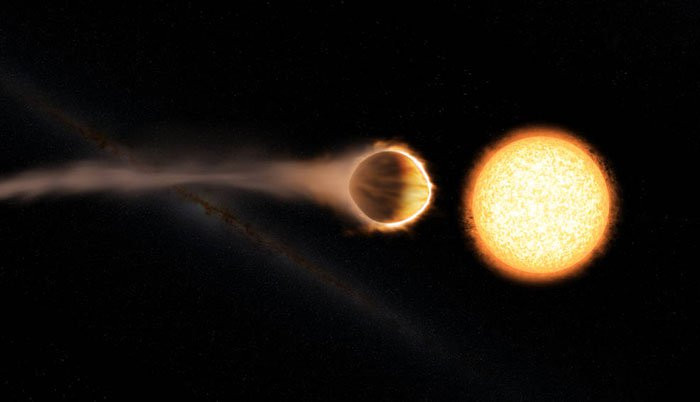The gem planet has two faces: one side in eternal daylight and the other in eternal night, shrouded in metallic clouds.
An international research team led by the National Center of Competence in Research Planetary Sciences at the University of Bern and the University of Geneva (Switzerland) has “penetrated” the atmosphere of WASP-121b, a super-hot exoplanet.
This planet orbits its host star at a distance about 40 times closer than the distance between the Sun and Earth, resulting in an immense amount of heat.
According to Dr. Jens Hoeijmakers, one of the lead authors of the study, they examined data using the HARPS spectrograph and identified at least seven metals existing in gaseous form on this planet: iron, chromium, calcium, sodium, magnesium, and nickel.
Previously, in 2019, when this strange planet was first discovered, it attracted attention from the scientific community because it is not a spherical body but rather… has an oval shape. The reason for this is that it orbits too close to its host star and is strongly pulled by the star’s gravity, distorting its spherical shape. It is possible that in the future, it will soon be destroyed in this uneven tug-of-war.
The “hellish” planet WASP-121b, discovered four years ago in the constellation Corvus, turns out to have a shape that is not similar to a round ball but resembles a long oval or a giant rugby ball.
“We started to focus on observing this planet because of its ‘extreme’ nature. We attempted to see traces of magnesium, iron, and other metals in the outer atmosphere and were very surprised to find them at a great distance from this planet,” stated expert David Singh from Johns Hopkins University in Baltimore (USA).

Due to its proximity, the upper atmosphere of the planet reaches temperatures of up to 2,500°C.
WASP-121b is a giant gas planet nearly twice the size of Jupiter and orbits its host star. This exoplanet is so close to its host star that a year there is only 1.3 days long on Earth. Due to its proximity, the upper atmosphere of the planet reaches temperatures of up to 2,500°C, about half the surface temperature of the Sun. At that temperature, iron exists in gaseous form instead of solid as usual.
The night side of the planet is an intriguing world, where temperatures are only “moderately hot” enough for the previously detected metals in the atmosphere to turn into clouds. These include vanadium, iron, chromium, calcium, sodium, magnesium, and nickel, but aluminum and titanium are absent.
Aluminum and titanium are thought to have condensed and sunk deeper into the lower layers of the atmosphere. There, aluminum combines with oxygen to form corundum. When the metal clouds in the upper layers descend and encounter corundum, if they react similarly to those on Earth, they could produce rubies and sapphires.
However, if that occurs, rubies and sapphires would be in liquid form: a gemstone rain that seems to exist only in mythology.
WASP-121 aggressively penetrates the atmosphere of its moons, causing it to be “inflated” by the effects of heat and light, and also influenced by its gravitational pull. As a result, WASP-121b becomes not only the hottest and most extreme planet but also one with a bizarre appearance.
The exoplanet WASP-121b and its host star.
“This super-hot exoplanet will become a benchmark for our atmospheric models. It will be a major observational target in the era of the James Webb Space Telescope,” said scientist Hannah Wakeford at NASA’s Goddard Space Flight Center, a co-author of the study.


















































